Laying a gas pipeline in a case through a wall: the specifics of a device for introducing a pipe for gas into a house
Connecting gas to a private house is not an affordable procedure for everyone, but due to the low cost of fossil fuels, it pays off in the coming years. Almost all work, except for earthworks and some installation works, is carried out by gas service employees at a predetermined price list.
To save money, homeowners take part of the activities - for example, dig a trench from the highway to the house. They can also participate in a process such as laying a gas pipeline in a case through a wall. If you figure it out, then you can handle this procedure yourself, while representatives of Oblgaz take 8-10 thousand rubles for this.
For those who decided to arrange the gas pipe into the house with their own hands, we gathered in one place all the information about the sleeve. You will learn everything from the regulatory framework to practical advice from the article we presented. Our advice will be useful to independent owners of suburban property.
The content of the article:
Features of entering the gas pipeline into the house
The process of shelling is available to anyone who held a hammer in his hand and participated in the construction of the house. But there are a number of nuances required for any work with gas connection and with gas equipment. This is due to the protection of the pipeline, and the safety of residents.
First, we will analyze what a case for a gas pipe is and why it is needed, and then we will dwell in more detail on the process of laying a gas pipeline through a wall.
At what stage is the case installed?
The gas system, located from the point of insertion into the central gas distribution line to the equipment installed in the house is called an internal gas pipeline. Simply put, this is not only the wiring installed inside the house, but also a branch located in the courtyard - underground, above ground and on a site near the wall of the building.
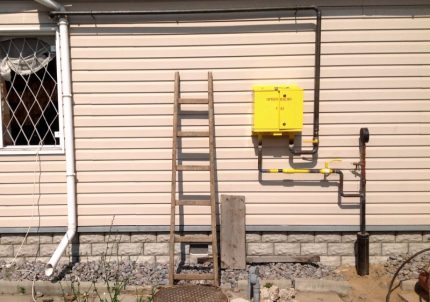
The underground gas pipeline, respectively, is included in the project for connecting gas to the house. By standards, low-pressure gas is supplied to residential buildings - this is important when choosing equipment.

The question arises: when and where is it better to install a case for entering a pipe into a house? Theoretically, this can be done immediately after the approval of the project, when the installation sites for gas equipment and the exit of the pipeline from the ground are precisely known.
Usually they tend to reduce the distance between these two points, that is, the gas line is brought out as close to boiler house or other non-residential premises where it is planned to install or have already installed gas units - columns, boilers, stoves.

It is best to make a hole in the wall when the outlet of the gas pipeline from the earth to the outside is already equipped. If the highway is elevated, then after it is connected to the house, in order to more accurately determine the place of entry. In other words, the most successful moment for laying a gas pipeline in a case is the end of internal and external work.
What is sleeve needed for?
According to regulatory requirements, carry out any communications - gas, water, heating, sewer pipes, chimneys and ventilation ducts - Through walls without additional reinforcement is prohibited.
The case or sleeve acts as a protective structure - a durable metal casing that protects the pipe from mechanical damage.
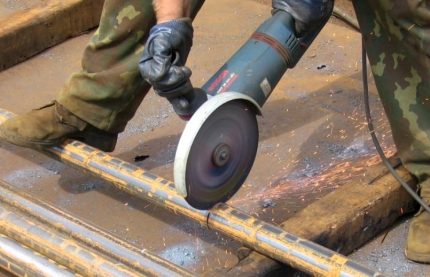
The main task of the case on the steel internal gas pipeline is to take the wall voltage onto itself and to remove the load from the pipeline. The use of cases is typical for the installation of gas pipelines.
For example, it is mandatory for laying gas pipes under automobile or railway tracks, as well as in soils that do not quite meet the installation conditions - heaving or flooded.
The case for installation in the wall differs from the special equipment placed during the installation of distribution lines, however, it must also be durable and wear-resistant.
For this reason, it is forbidden to use polystyrene, polyethylene or other polymers as a sleeve - only steel, stainless or additionally treated from corrosion is suitable.
The regulatory framework is the basis of work
What to do if you are not sure about the choice of material or if representatives of the inspection authority have any complaints? It is better to hedge and perform installation work, based on legally accepted standards.
You just need to refer to the document SP 42-101-2003, and more precisely, to paragraph 6.7, which precisely indicates the nuances of the choice of material and installation:
- as insulating material, which serves as a gasket between the pipe and the case, use rubber sleeves, tarred tow or other material similar in characteristics;
- the gap on the outside of the case is tightly sealed with concrete;
- the distance from the pipe wall to the wall of the case is at least 10 mm, with the exception of pipes with a diameter <32 mm - at least 5 mm;
- the sleeve should not extend beyond the boundaries of the wall, but if the pipe crosses a horizontal ceiling, the case should protrude 50 mm from both sides.
Another very important condition is that a pipe enclosed in a case must not have any detachable or welded joints.

The aesthetics of the building will not be affected, since at the end of work the installation site of the case is decorated with decorative material on the outside, and with plaster inside. If the house is wooden, and sheathing is not planned, we recommend that the work on the sleeve is carried out more accurately.
Making or buying?
On sale you can find a large number of ready-made solutions - from inexpensive stamped 20-ruble shells of small diameter to products made of thick-walled structural steel. Almost all cases are universal, that is, they are used to make penetrations for any communications, including gas.
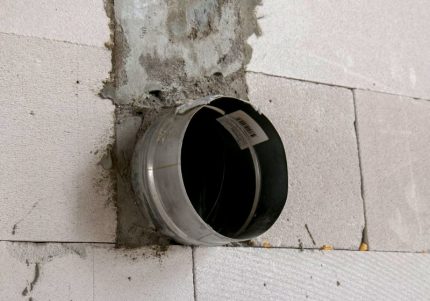
But if there is no desire to use the purchased part, and at hand a lot of material left over from the construction of the house, then you can make a sleeve with your own hands. A large diameter pipe is suitable, according to the norms - approximately 20 mm higher than the gas pipe.
A fragment is cut from the pipe, equal in length to the width of the wall - its edges should not protrude beyond the surface. The ends are cleaned so that they do not have any burrs or sharp ribs. Then the blank is coated with a protective paint for metal, preferably in 2 layers - the sleeve is ready.
Installation Instructions
The installation process is simple and takes a little time. In advance, it is necessary to prepare a tool for punching the wall and material for sealing cavities between the sleeve and the wall.
Step-by-step instruction:
- Make a hole in the wall with a diameter greater than design diameter of the gas pipeline, in the place defined by the project.
- Put the sleeve inside the hole, check if it matches the size.
- The gap between the sleeve and the wall is tightly filled with concrete.
- Wait until the solution dries and check the installation stability.
The rest of the work is usually carried out by gas service employees — they lay a gas pipeline and isolate it.
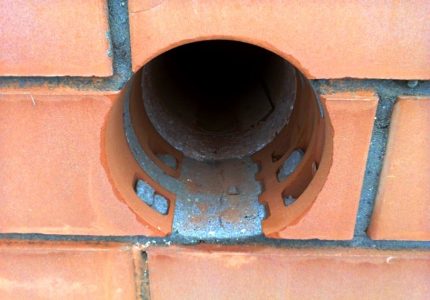
If the house is wooden, then a large hole in the beam can be made a drill by drilling around the perimeter or by using a large diameter crown.
Differences in the introduction of bottled gas
Gas cylinders are placed in a metal box outside the house, and the connection to the stove is made by means of a flexible rather than a metal hose.
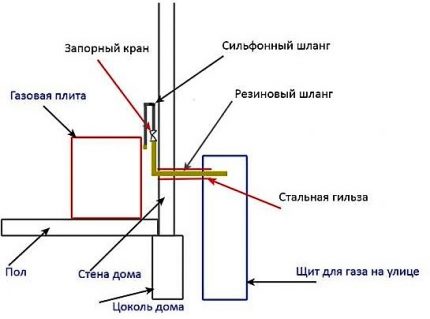
The house is square, and gas hose - small diameter, so making a hole and installing the case is easy.
You can not install a sleeve between the bars or logs, it is recommended to drill a hole in the middle.
Conclusions and useful video on the topic
How not to lay a gas pipe through the wall:
Do-it-yourself sleeve installation:
Using the brick wall case:
The passage of the pipe through the wall is not the most difficult and time-consuming step in the process of gasification of a private house, but it requires both compliance with regulatory requirements and accuracy in work. So that in the future there would be no problems with the gas service, we recommend that you act strictly according to the project and coordinate all work with employees of the controlling authority.
Want to talk about your own experience in the construction of a sleeve for introducing a gas pipe into a house? Do you have useful information on the topic of the article? Please write comments in the form below, ask questions, post thematic photographs.

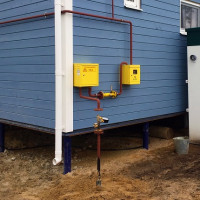 Gas pipeline exit from the ground: requirements and features of the arrangement of the exit node
Gas pipeline exit from the ground: requirements and features of the arrangement of the exit node 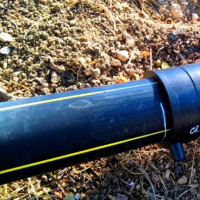 Polyethylene pipes for a gas pipeline: types and specifics of laying pipelines made of polyethylene
Polyethylene pipes for a gas pipeline: types and specifics of laying pipelines made of polyethylene 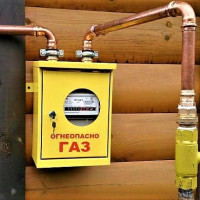 Copper pipes for gas: specifics and norms for laying a copper pipeline
Copper pipes for gas: specifics and norms for laying a copper pipeline  How is gas connected to a private house: input device + system installation
How is gas connected to a private house: input device + system installation 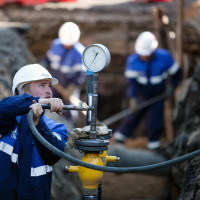 Gas line pressure testing: how are control tightness tests carried out
Gas line pressure testing: how are control tightness tests carried out 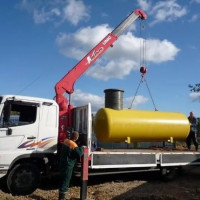 Turnkey gas holder: how to install a gas tank and install equipment
Turnkey gas holder: how to install a gas tank and install equipment  How much does it cost to connect gas to a private house: the price of organizing gas supply
How much does it cost to connect gas to a private house: the price of organizing gas supply  The best washing machines with dryer: model rating and customer tips
The best washing machines with dryer: model rating and customer tips  What is the color temperature of light and the nuances of choosing the temperature of the lamps to suit your needs
What is the color temperature of light and the nuances of choosing the temperature of the lamps to suit your needs  Replacement of a geyser in an apartment: replacement paperwork + basic norms and requirements
Replacement of a geyser in an apartment: replacement paperwork + basic norms and requirements
I have an old house, the 70s .. Gas workers ask if I have a sleeve? I suspect not. So now, in order to lay it, do I need to hollow the wall, remove the existing gas pipeline, and then re-enter it?